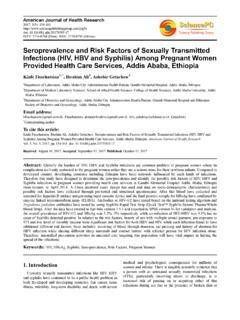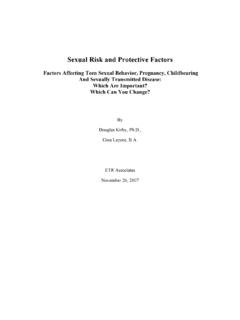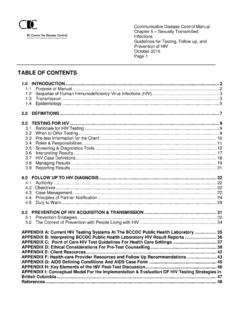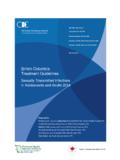Transcription of Transmission and prevention of HIVand sexually …
1 EDITORIAL REVIEWT ransmission and prevention of HIV and sexuallytransmitted infections in war settings: implications forcurrent and future armed conflictsCatherine A. Hankinsa,b ,Samuel R. Friedmanc ,Tariq ZafardandSteffanie A. StrathdeeeAIDS2002,16:2245 2252 Keywords: Asia ,HIV , sexually transmitted infections , sexually transmitteddiseases , prevention of sexual and blood-borne Transmission ,injection drug use ,war settings ,AfghanistanIntroductionArmed conflicts often constitute complex emergen-cies , defined as situations affecting large civilian popu-lations which combine war or civil strife with foodshortages and population displacement [1,2].
2 Wars canincrease the spread of sexually transmitted infections(STI) and facilitate HIV Transmission through sexualroutes, injection drug use (IDU), contaminated bloodtransfusions and occupational injuries; furthermore,they can create synergistic conditions for interactingepidemics. Armed conflicts can influence HIV epi-demic dynamics in surrounding countries and beyond,both directly by affecting HIV Transmission itself andindirectly through reallocation of health-related publicfunds toward security and defense , powerlessness and social instability, all ofwhich facilitate HIV Transmission , are extremely heigh-tened in complex emergencies, but HIV is rarely seenas a priority [3].
3 We review the effects of war on HIVand STI Transmission and critically appraise short- andmedium-term approaches to prevention . Our intent isto stimulate thinking about the potential for increasedHIV/STI Transmission in current and future armedconflicts, with particular reference to Afghanistan, andto encourage timely interventions to prevent a worsen-ing HIV epidemic in Central and South effects of war on sexualtransmission of HIV and STIIn World War I, high reported STI rates amongsoldiers reflected both high syphilis and gonorrheaprevalence in civilian populations and conditions con-ducive to acquisition and Transmission in the 1917, 23 000 British soldiers were hospitalized withSTI while, from 1914 1917, over a million syphilisand gonorrhea cases were recorded among civilians inFrance [4].
4 In World War II, more than 750 000 United States of America (USA) military draftees hadpositive syphilis serologic tests and/or clinical symp-From theaJoint Departments of Epidemiology, Biostatistics and Occupational Health, McGill University; McGill University AIDSC entre, Montre al;bInstitut National de Sante Publique du Que bec, Montre al, Canada;cInstitute for AIDS Research, NationalDevelopment an dResearch Institutes, New York, USA;dNai Zindagi, Islamabad, Pakistan andeJohns Hopkins University,Bloomberg School of Public Health, Baltimore, Maryland, to Catherine Hankins MD, MSc, CCFP, FRCPC, Department of Social Mobilization and Strategic Information,UNAIDS, 20 avenue Appia, 1211 Geneva 27, : +41 22 791 3865; fax: +41 22 791 4741; e-mail: 21 February 2002; revised: 9 August 2002; accepted: 19 August 0269-9370&2002 Lippincott Williams & Wilkins2245toms [4].
5 Deploying troops without actual combat inthe early 1970s in Korea is thought to have contributedto high STI rates, exceeding those of the war inVietnam [5].More recently, wars have been important mechanismsfor disseminating HIV infection. By 1987, HIV hadspread from northern areas of Angola to central andsouthern regions, accompanying war-induced popu-lation displacement [6]. High HIV infection rates in ElSalvador soldiers were attributed to high levels ofsexual risk behavior associated with the 12 year civilwar and numerous prostitution centers surroundingmilitary posts [7].
6 Ethnic patterns of recruitment intoUganda s National Liberation Army after the over-throw of Idi Amin in 1979 correlated positively withgeospatial distributions of Ugandan AIDS cases in1990, supporting the hypothesis of military involve-ment in HIV spread [8]. By 1998, a decade of ethnicwar, upheaval and mass movements of refugees fromviolence in Rwanda had fanned an escalating HIVepidemic that spread from cities such as Kigali to thecountryside [9].
7 In Sierra Leone, sexual contacts withforeign soldiers from countries with high HIV seropre-valence preceded rapid increases in rates of STI andHIV [10].War can severely disrupt access to food and othernecessities, generating significant population move-ments as refugees flee violence and starvation. Refu-gees are highly vulnerable to sexual predation by thosewith food or money and to rape by those withweapons. For example, in Mozambique, social disrup-tion, war and compromised health infrastructure likelyprovoked higher syphilis rates in 1992 1993 amongdisplaced pregnant women, some of whom had ex-perienced sexual abuse and repeated rape while beingheld captive by insurgents [11].
8 The extent of sexualabuse in situations of armed conflict and civil unrest isnot well described and may be under-reported due toassociated stigma, emotional disturbance and fear ofrecrimination [12]. Unaccompanied minors are atparticular risk of sexual violence during wars. Rape,whether by homeland or foreign soldiers, may beused to systematically terrorize and displace populations[13,14]. HIV risk increases if there are multipleperpetrators or if women are held in captivity for longperiods [10].
9 In the context of an emerging HIVepidemic, widespread sexual violence can have devas-tating health in complex emergencies may use transactionalor survival sex with men who have food or money toavoid starvation for themselves and their children [15 17]. In Sierra Leone, war altered sexual networksthrough massive displacement of populations, psycho-logical trauma, and progressive impoverishment ofwomen [10]. Deaths or loss of contact with spouses frequent concomitants of war may lead men andwomen to seek new partners in situations wherenormal social controls of sexuality by relatives andneighbors are disrupted [18].
10 In Sudanese refugeecamps in northern Uganda in 1996, beer brewing andselling were common activities for young refugeewomen, most of whom were separated or widoweddue to war. Unprotected sex with multiple partnerswhile under the influence of alcohol was common[19].In conflict situations, psychological contexts may alsoincrease risk behaviors and risk networks. Changingpatterns of sexual behavior, drug use, and increasedHIV/STI risk were found in 1998 among youngpeople displaced by war in Bosnia Herzegovina [20].
















